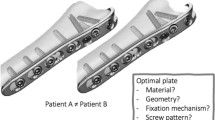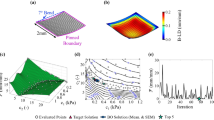Abstract
Open and endovascular treatments for peripheral arterial disease are notorious for high failure rates. Severe mechanical deformations experienced by the femoropopliteal artery (FPA) during limb flexion and interactions between the artery and repair materials play important roles and may contribute to poor clinical outcomes. Computational modeling can help optimize FPA repair, but these simulations heavily depend on the choice of constitutive model describing the arterial behavior. In this study finite element model of the FPA in the standing (straight) and gardening (acutely bent) postures was built using computed tomography data, longitudinal pre-stretch and biaxially determined mechanical properties. Springs and dashpots were used to represent surrounding tissue forces associated with limb flexion-induced deformations. These forces were then used with age-specific longitudinal pre-stretch and mechanical properties to obtain deformed FPA configurations for seven age groups. Four commonly used invariant-based constitutive models were compared to determine the accuracy of capturing deformations and stresses in each age group. The four-fiber FPA model most accurately portrayed arterial behavior in all ages, but in subjects younger than 40 years, the performance of all constitutive formulations was similar. In older subjects, Demiray (Delfino) and classic two-fiber Holzapfel–Gasser–Ogden formulations were better than the Neo-Hookean model for predicting deformations due to limb flexion, but both significantly overestimated principal stresses compared to the FPA or Neo-Hookean models.








Similar content being viewed by others
References
Adam DJ, Beard JD, Cleveland T et al (2005) Bypass versus angioplasty in severe ischaemia of the leg (BASIL): multicentre, randomised controlled trial. Lancet 366:1925–34. doi:10.1016/S0140-6736(05)67704-5
Ansari F, Pack LK, Brooks SS, Morrison TM (2013) Design considerations for studies of the biomechanical environment of the femoropopliteal arteries. J Vasc Surg 58:804–813. doi:10.1016/j.jvs.2013.03.052
Baek S, Gleason RL, Rajagopal KR, Humphrey JD (2007) Theory of small on large: potential utility in computations of fluid–solid interactions in arteries. Comput Methods Appl Mech Eng 196:3070–3078. doi:10.1016/j.cma.2006.06.018
Cheng CP, Choi G, Herfkens RJ, Taylor Ca (2010) The effect of aging on deformations of the superficial femoral artery resulting from hip and knee flexion: potential clinical implications. J Vasc Interv Radiol 21:195–202. doi:10.1016/j.jvir.2009.08.027
Conte MS, Bandyk DF, Clowes AW et al (2006) Results of PREVENT III: a multicenter, randomized trial of edifoligide for the prevention of vein graft failure in lower extremity bypass surgery. J Vasc Surg 43:742–751. doi:10.1016/j.jvs.2005.12.058
Conti M, Marconi M, Campanile G et al (2016) Patient-specific finite element analysis of popliteal stenting. Meccanica. doi:10.1007/s11012-016-0452-9
Delfino A (1996) Analysis of stress field in a model of the human carotid bifurcation. THES, Ecole Polytechnique Federale DeLausanne
Demiray H, Weizsacker HW, Pascale K, Erbay HA (1988) A stress–strain relation for a rat abdominal aorta. J Biomech 21:369–374
Diehm N, Sin S, Hoppe H et al (2011) Computational biomechanics to simulate the femoropopliteal intersection during knee flexion: a preliminary study. J Endovas Ther 18:388–396. doi:10.1583/10-3337.1
Ferruzzi J, Vorp DA, Humphrey JD (2011) On constitutive descriptors of the biaxial mechanical behaviour of human abdominal aorta and aneurysms. J R Soc Interface 8:435–450
Holzapfel GA, Gasser TC, Ogden RW, W OR (2000) A new constitutive framework for arterial wall mechanics and a comparative study of material models. J Elast 61:1–48
Jani B, Rajkumar C (2006) Ageing and vascular ageing. Postgrad Med J 82:357–62. doi:10.1136/pgmj.2005.036053
Kamenskiy A, Dzenis Y, Kazmi SAJ et al (2014a) Biaxial mechanical properties of the human thoracic and abdominal aorta, common carotid, subclavian, renal and common iliac arteries. Biomech Model Mechanobiol 13:1341–1359. doi:10.1007/s10237-014-0576-6
Kamenskiy AV, Pipinos II, Dzenis YA et al (2014b) Passive biaxial mechanical properties and in vivo axial pre-stretch of the diseased human femoropopliteal and tibial arteries. Acta Biomater 10:1301–1313. doi:10.1016/j.actbio.2013.12.027
Kamenskiy AV, Pipinos II, Dzenis Ya et al (2015) Effects of age on the physiological and mechanical characteristics of human femoropopliteal arteries. Acta Biomater 11:304–313. doi:10.1016/j.actbio.2014.09.050
Kamenskiy A, Seas A, Bowen G et al (2016a) In situ longitudinal pre-stretch in the human femoropopliteal artery. Acta Biomater 32:231–237. doi:10.1016/j.actbio.2016.01.002
Kamenskiy A, Seas A, Deegan P et al (2016b) Constitutive description of human femoropopliteal artery ageing. Biomech Model Mechanobiol. doi:10.1007/s10237-016-0845-7
Lee H-Y, Oh B-H (2010) Aging and arterial stiffness. Circ J 74:2257–2262. doi:10.1253/circj.CJ-10-0910
Liberson AS, Lillie JS, Day SW, Borkholder DA (2016) A physics based approach to the pulse wave velocity prediction in compliant arterial segments. J Biomech. doi:10.1016/j.jbiomech.2016.09.013
MacTaggart J, Phillips N, Lomneth C et al (2014) Three-dimensional bending, torsion and axial compression of the femoropopliteal artery during limb flexion. J Biomech 47:2249–2256
Mahoney EM, Wang K, Cohen DJ et al (2008) One-year costs in patients with a history of or at risk for atherothrombosis in the United States. Circ Cardiovasc Qual Outcomes 1:38–45. doi:10.1161/CIRCOUTCOMES.108.775247
Mahoney EM, Wang K, Keo HH et al (2010) Vascular hospitalization rates and costs in patients with peripheral artery disease in the United States. Circ Cardiovasc Qual Outcomes 3:642–51. doi:10.1161/CIRCOUTCOMES.109.930735
Masson I, Beaussier H, Boutouyrie P et al (2011) Carotid artery mechanical properties and stresses quantified using in vivo data from normotensive and hypertensive humans. Biomech Model Mechanobiol 10:867–882. doi:10.1007/s10237-010-0279-6
Ní Ghriallais R, Bruzzi M (2013) Effects of knee flexion on the femoropopliteal artery: a computational study. Med Eng Phys 35:1620–1628. doi:10.1016/j.medengphy.2013.05.015
Ní Ghriallais R, Bruzzi M (2014) A computational analysis of the deformation of the femoropopliteal artery with stenting. J Biomech Eng 136:1–10. doi:10.1115/1.4027329
Nolan DR, Gower aL, Destrade M et al (2014) A robust anisotropic hyperelastic formulation for the modelling of soft tissue. J Mech Behav Biomed Mater 39:48–60. doi:10.1016/j.jmbbm.2014.06.016
Petrini L, Trotta A, Dordoni E et al (2016) A computational approach for the prediction of fatigue behaviour in peripheral stents: application to a clinical case. Ann Biomed Eng 44:536–547. doi:10.1007/s10439-015-1472-7
Schillinger M, Sabeti S, Loewe C (2006) Balloon angioplasty versus implantation of nitinol stents in the superficial femoral artery. N Engl J Med 354:1879–1888
Schillinger M, Sabeti S, Dick P et al (2007) Sustained benefit at 2 years of primary femoropopliteal stenting compared with balloon angioplasty with optional stenting. Circulation 115:2745–9. doi:10.1161/CIRCULATIONAHA.107.688341
Shroff GR, Cen Y-Y, Duprez DA, Bart BA (2009) Relationship between carotid artery stiffness index, BNP and high-sensitivity CRP. J Hum Hypertens 23:783–787
Siracuse JJ, Giles K, Pomposelli FB et al (2012) Results for primary bypass versus primary angioplasty/stent for intermittent claudication due to superficial femoral artery occlusive disease. J Vasc Surg 55:1001–1007. doi:10.1016/j.jvs.2011.10.128
Vergori L, Destrade M, McGarry P, Ogden RW (2013) On anisotropic elasticity and questions concerning its finite element implementation. Comput Mech 52:1185–1197. doi:10.1007/s00466-013-0871-6
Wadman MC, Lomneth CS, Hoffman LH et al (2010) Assessment of a new model for femoral ultrasound-guided central venous access procedural training: a pilot study. Acad Emerg Med 17:88–92. doi:10.1111/j.1553-2712.2009.00626.x
Acknowledgements
Research reported in this publication was supported in part by National Heart, Lung, And Blood Institute of the National Institutes of Health [Grant Numbers R01 HL125736 and F32 HL124905]. The authors also wish to acknowledge the Nebraska Organ Recovery System (NORS), and the Charles and Mary Heider Fund for Excellence in Vascular Surgery for their help and support.
Funding This study was supported in part by the National Heart, Lung, And Blood Institute of the National Institutes of Health under Award Numbers R01 HL125736 and F32 HL124905.
Author information
Authors and Affiliations
Corresponding authors
Ethics declarations
Conflict of interest
The authors declare that they have no conflict of interest.
Rights and permissions
About this article
Cite this article
Desyatova, A., MacTaggart, J., Poulson, W. et al. The choice of a constitutive formulation for modeling limb flexion-induced deformations and stresses in the human femoropopliteal arteries of different ages. Biomech Model Mechanobiol 16, 775–785 (2017). https://doi.org/10.1007/s10237-016-0852-8
Received:
Accepted:
Published:
Issue Date:
DOI: https://doi.org/10.1007/s10237-016-0852-8




